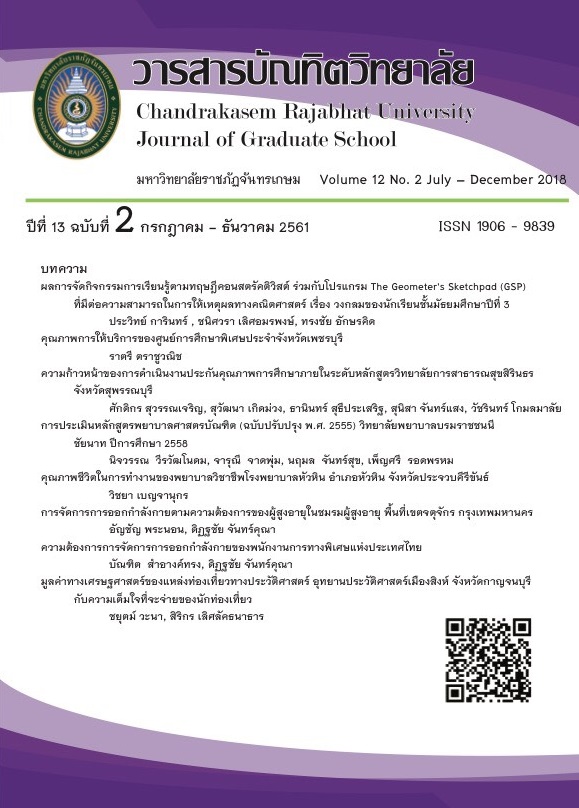The Progress of Internal Curriculum Quality Assurance of Sirindhorn College of Public Health, Suphanburi
Main Article Content
Abstract
The trend research has objectives to analyze trends and report progress of the implementation based on the results of the internal curriculum quality assurance and factors affecting the internal curriculum quality assurance of Bachelor of Public Health program (new curriculum B.E. 2555 and revised curriculum B.E. 2559), academic year 2014-2016. The results of the curriculum quality assurance of Praboromarajchanok Institute for Health Workforce Development in 2014 and 2016 and those from Institute of Medical and Public Health Technology in 2015 were collected. The data from 6 components and 14 indicators including input, process, and output were analyzed and compared by the Mann-Whitney Rank Sum Test. The data from the related documents was processed through the content analysis method.
The results of the curriculum quality assurance revealed tendency of an improved performance during the academic year of 2014-2016 (with the average scores of 3.04, 3.20, and 3.40 respectively). For the indicator 1.1, it was found that the curriculum was standardized according to the criteria under the Bachelor's degree program in B.E. 2548 and 2558. The results showed difference with statistical significance (p<0.5) in the academic year of 2014 and 2016. Considering the input, process, and output yielded that the input (indicators 3.1, 3.2, 3.3, 4.1, 4.2, 4.3, and 5.1) improve during the academic year 2014 – 2016 was identified with the scores 2.85, 3.10, and 3.25 respectively. The process (indicators 5.2, 5.3, 5.4, and 6.1) were likely to decline in the academic year 2015 and develop in the academic year 2516 with scores of 3.50, 3.13, and 3.44 respectively. In terms of the output (indicators 2.1 and 2.2), the tendency cannot be predicted because there was only 1 class of the graduates from the Bachelor of Public Health program (revised curriculum B.E.2555) in the academic year 2015. The factors affecting the scores of the internal curriculum quality assurance included 1) implementation based on PDCA process; 2) management review based on the results from the committees and the implementation of the improvement plan and consistent summaries, follow-ups and evaluations; 3) capabilities improvement for the curriculum endorsers; and 4) integration of quality assurance with curriculum management or routine tasks; 5) knowledge management of how to improve the system and mechanism of the internal curriculum quality assurance. The results from the studies yielded an improved performance from the academic year of 2014 to 2016 which could be applied as the guidelines for implementing the internal curriculum quality assurance, planning and improving the performance in the following academic year.
Article Details
References
2. คณะกรรมการประเมินคุณภาพการศึกษาภายใน ระดับหลักสูตร ปีการศึกษา 2558. (2558). รายงานผลการประเมินคุณภาพการศึกษาภายในระดับหลักสูตร หลักสูตรสาธารณสุขศาสตรบัณฑิต สาขาวิชาสาธารณสุขชุมชน (หลักสูตรใหม่ พ.ศ. 2555) ประจำปีการศึกษา 2558. สถาบันวิชาการสาธารณสุขเทคโนโลยีทางการแพทย์: สถาบันพระบรมราชชนก สำนักงานปลัดกระทรวงสาธารณสุข.
3. คณะกรรมการประเมินคุณภาพการศึกษาภายใน ระดับหลักสูตร ปีการศึกษา 2559. (2559). รายงานผลการประเมินคุณภาพการศึกษาภายในระดับหลักสูตร หลักสูตรสาธารณสุขศาสตรบัณฑิต สาขาวิชาสาธารณสุขชุมชน (หลักสูตรปรับปรุง พ.ศ. 2559) ประจำปีการศึกษา 2559. นนทบุรี: สถาบันพระบรมราชชนก สำนักงานปลัดกระทรวงสาธารณสุข.
4. จงกล จันทร์เรื่อง, ธนินทร์ ระเบียบโพธิ์, และเอกลักษณ์ ฉิมจารย์. (2556). การบูรณาการงานประกันคุณภาพการศึกษากับการจัดการเรียนการสอน การบริการวิชาการแก่สังคมและงานวิจัย. วารสาร มทร อีสาน, 6(1), 94-103.
5. เบญจวรรณ วงศ์ปราชญ์. (2560). ระบบและกลไกการประกันคุณภาพการศึกษาภายใน วิทยาลัยพยาบาลกองทัพบก. วารสารพยาบาลทหารบก, 18(3), 16-25.
6. ปาริฉัตร จันทร์นวล และธีระวัฒน์ จันทึก. (2558). การคาดการณ์ระดับความสำเร็จในการบริหารงานด้านการประกันคุณภาพการศึกษาภายในระดับหลักสูตรของมหาวิทยาลัยราชภัฎสวนสุนันทา. วารสารบัณฑิตศึกษา มหาวิทยาลัยราชภัฏสวนสุนันทา, 2(2), 164-181.
7. สำนักงานคณะกรรมการการอุดมศึกษา กระทรวงศึกษาธิการ. (2557). คู่มือการประกันคุณภาพการศึกษาภายในระดับอุดมศึกษา พ.ศ. 2557 (พิมพ์ครั้งที่ 4). กรุงเทพฯ: ภาพพิมพ์.
8. สำนักมาตรฐานและประเมินผลอุดมศึกษา สำนักงานคณะกรรมการการอุดมศึกษา กระทรวงศึกษาธิการ. (2560). เกณฑ์มาตรฐานหลักสูตรระดับอุดมศึกษา พ.ศ. 2558 และเกณฑ์มาตรฐานที่เกี่ยวข้อง. กรุงเทพฯ: วงศ์สว่างพับลิชชิ่ง แอนด์ พริ้นติ้ง.
9. Demimg, W.E. The Deming Cycle. (1993). The New Economics for Industry, Government, Education. Cambridge MA: MIT Press.

